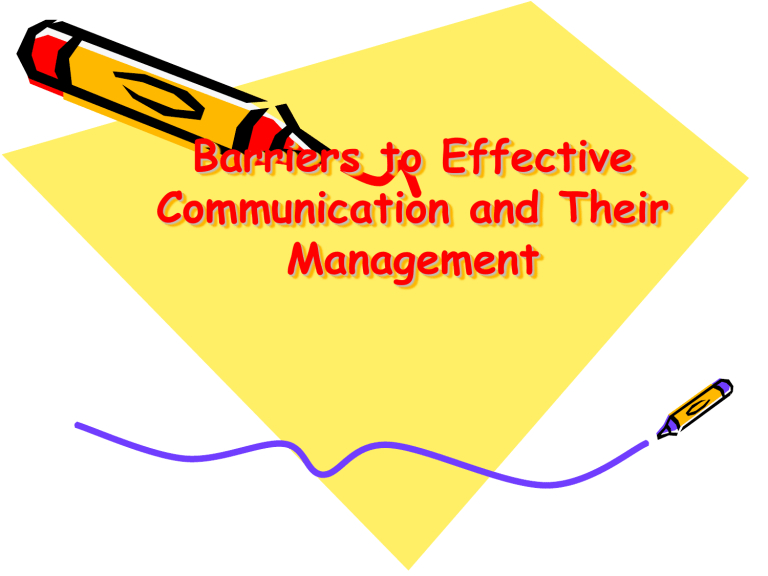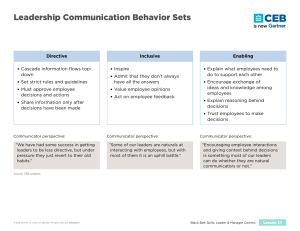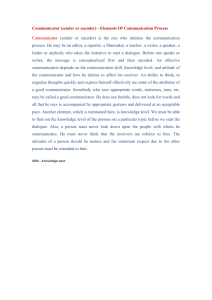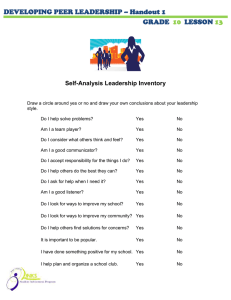
Barriers to Effective Communication and Their Management Points of Discussion • • • • • Communication-what it is? Significance of communication Process of Communication Barrier? Barriers to communication COMMUNICATION Tuğçe AYDIN What is communication? • Communication is a process through which two or more people exchange information, ideas, thoughts, emotions in such a way that each gain a common understanding of the intended message. • Communication is a dyadic concept. • In Communication system 35% message is carried verbally and rest of the 65% non verbally. COMMUNICATION Communication is the process of sending and receiving messages between parties Basic Model Of Communication Source Encoded Channel Feedback Decoded Receiver Significance of Communication • Lifeblood of an individual, organisation, society • As you grow you communicate more and more • In all domains of life and in all directions Downwards Sideways Upwards BARRIERS FOR EFFECTIVE COMMUNICATION Ayşe Bilge ÇAKIR Barrier ? • Lack of Commonness is barrier • A barrier to interpersonal communications is anything that prevents, restricts or impedes the conveyance of meaning by words or gestures between two or more persons in a social setting. • The term ‘Barriers’, ‘Obstacles’, ‘ Hindrances’ and ‘noise’ are all used to describe the distracting stimuli • associated with the • communication process Absence of defined role of any component = Creates Barrier Barriers to Effective Communication • • • • • • • Social Psychological Cultural Physiological, System design Physical Receivers Social Barriers Gender Age Race National or Cultural Origin Socioeconomic Class Education Level Urban or Rural Residence GENDER Major influence on the way we communicate with others. When men and women work together in a group, men tend to be more assertive and self-confident. Women are more likely than men to express their emotions, to reveal how they feel about a situation. AGE Young people and old people communicate in different ways. We do tend to judge a statement by different standards if we know the speaker’s age. A person’s age or gender is not important in judging the truth or wisdom of what that person says . Their maturity, their educational backgrounds, and the different eras in which they grew up make a Generation Gap inevitable. Social Barriers Cont….. • Purpose of Communication – Informative, entertaining and persuasive – Purpose not clear/missing/at odds • Social Noise/Subjective factors – Human relation/ personal preferences overshadow the objectivity of the communication. – Boys/Girls, Friends/enemies, Nice people Try to ensure the Objectivity. Do not get dragged by Subjective factors. Psychological Barriers • • • • • Attitude towards self Fear Attitude towards audience Attitude towards the message You Yourself is not convinced with the subject • Knowledge of subject • Personality/Status of the communicator PERCEPTION Our physical limitations are a screen through which we perceive things that exist in our environment. Our perception is also limited by psychological screens that we have developed. Choosing from among the many things within our range of perception those that we will notice, and block out the rest is called “Selective Perception” Mother: Will you straighten up your room? Teenager: Why? What’s messy? Selective Perception • Allows us not only to block out things that are there, but also to see more things than are there. • Leads us to make our own reality! • Most clearly seen in the human tendency to stereotype others. MOTIVATION A Motive is a Reason For Action! The most strongest motivations are those that are most personal. We are motivated by money, fame, power, love, status, security, skill, ambition...etc it can be both positive or negative. TUNNEL VISION A closed way of thinking, especially about abstract topics, such as religion and politics. • The person with tunnel vision is one who has firmly fixed ideas • The opposite side is open-mindedness • Person with tunnel vision has attitude seems to say; “I’ve already made up my mind, Don’t confuse me with the facts!!!” EGO DEFENSIVENESS A response pattern in which a person who follows this pattern sees a disagreement as a personal attact . A self-centered communication More than just being selfish NEGATIVE EMOTIONS Almost always obstacles to good communication! Especially true barrier if the emotion is uncontrolled, unfocused, or misdirected. Other Psychological Barriers • People’s State of Mind Happy, Sad • Personal Problems/Worries • Pre conceived notions of Communicator or Receiver • Mental limitations of human beings, failure to refer language to experience, the confusion of concept. Cultural Barriers Semantic Problems: Distortion in communication comes from semantics- the use of words or expressions which have a different meaning for the sender or receiver. Created when communicators use technical jargon- usage common to a particular field or specialization. Cultural Barriers • Language Different languages, dialect, individual linguistic ability, use of difficult words, inappropriate words, pronunciation • Norms and values • Belief • Social practices and traditions Physiological Barriers • Individuals’ personal discomfort ill health, poor eye sight, hearing difiiculties • Speech and voice defect, feeling of inferiority, diseases, physical appearance, lack of skill. System Design • Organisational Structure unclear, to whom to communicate, • Insufficient or inappropriate information systems • Information overloaded • A lack of clarity in roles and responsibilities • A lack of supervision or training The distortion of message is any kind of loss, deformation, miss presentation or alteration taken place in original message while sending it to audience. Types of Distortion : 1. Systematic Distortion – Purposely changed 2. Fog Distortion – information is lost 3. Mirage Distortion - extra, unwanted information Status And Power Differences Differences in communications are likely to parallel the differences in power. Imbalance or asymmetry in negotiating power leads the high power party to perform significantly better than the low power party. Physical Barriers • Channel – – – – – – Availability of channel to receiver (Common channel) Choice of channel Handling of channel by communicator Reach : depending on size of audience, mike, etc. Noise level in Channel Presentation of information/message treatment Muddled messages “Dogs for sale.Will eat anything.Especially likes children. Call 888-3599 for more information.” • Climate – Extreme temperature (Hot/Cold) – Bright/ Dim Light – High Humidity • Comfort Physical Barriers Cont….. Distractions:It occurs where people are constantly coming in and leaving for one reason or another, and experinced the frustration that is created by this distracting traffic flow. Physical Barriers Cont….. • Distractions – Noise (Co-workers, Doors, etc.) – Photographer – Any announcements – Instruction Sheet – Tea – Late Comers • Physical Setting of Classroom/ Lecture Hall – Sitting Arrangement – Audio-Visual Aids Receiver-The Ultimate • Absenteeism/Day Dreaming/ Pretending Listening • Strayers: They constantly take the group off the track. They drag the discussion out of context • Gabbers: They are the people who like to talk first and try to dominate in the discussion. They think that they are the only ones with anything worth saying • Silent: They are just as well informed as many other members of the group but they rarely contribute verbally Listening without observing speaker’s tone, gesture, posture and facial expression is like getting the words of a song without music Relating to Receiver • Problem of homogeneity: The more homogeneous the audience is, the greater are the chances for successful communication. • Problem of cooperation and involvement: The listeners must cooperate and get actively involved in the communication process, they must try to get tuned together with the communicator. • Negative attitude of the audience towards the communicator: If the audience has negative attitude for the communicator or if the credibility of communicator as perceived by the audience is low, no successful communication will take place. Problems in Communication Relating to Transmission of Message • Wrong handling of the channels: If the channels selected for communication are not handled effectively, their potential for carrying a message will be dissipated. • Wrong selection of channels: If the channel selected is not in accordance with the objective/subject, interpretation will not be in a desired way. • Use of inadequate channels in parallel: For the message to have got through and received properly, use of more than one channel in parallel or at about the same time is essential. • Physical distraction: Failure to avoid physical distraction often obstructs successful sending of the message. Points to Remember • Communication is a two way process. • Effective communication= Bridging the gap between encoded and decoded message= Establishing Common Understanding • Responsibility of effective communication mainly lies with the communicator • Feedback is an important return message. Ensure getting and using it effectively for better performance • Know the roadblocks. This will help you to handle the communication process in an effective way • Use Heart and Mind and Soul for an effective result • Communication is a skill, learn and practice To Sum up To Become an Effective communicator Make effective use of Heart and Body, Mind and Soul


